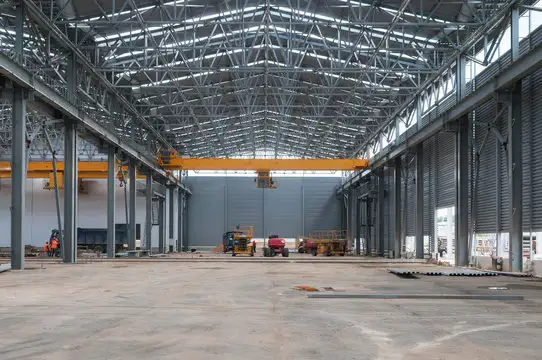There are expenses associated with building a church, such as design, permits, and construction. These cost $164.69 per square foot across the United States. However, specific needs vary these costs.
Constructing a church costs between $100 and $200 per square foot. Size, materials, and location mainly affect the final cost. Planning could make a difference here.
The size, type of building, materials used, and location all affect the overall cost. Simple designs are cheaper, while complex designs are costlier. Knowing these factors would help manage the budget better.
Average Cost of Building a Church

The cost of constructing a church varies considerably based on factors such as the size, location, design complexity, and the materials used to ensure the construction. Here are the averaged costs based on church size:
| Church Size | Average Cost Per Sq. Ft | Example Size (Sq. Ft.) | Estimated Total Cost |
| Small Church | $100–$200 | 5,000 | $500,000–$1,000,000 |
| Medium Church | $150–$250 | 15,000 | $2,250,000–$3,750,000 |
| Large Church | $200–$400 | 25,000 | $5,000,000–$10,000,000 |
Factors That Affect the Cost of Building a Church
Establishing a church involves many crucial elements in determining the financial provision it would take to build such an establishment.
The major consideration includes the following:
- Location: The points on which land, labor, and materials cost will depend purely on where the church is constructed. In most cases, urban places are always costlier than rural places.
- Size and Design: Larger churches or those built with complex architecture, like stained glass windows or high architectural elements, will increase overall costs.
- Materials: Various types and qualities of materials such as stone, brick, steel, and wood have affected both the price and longevity of a building.
- Foundation and Site Preparation: The land should be cleared, leveled, and prepared for construction. Costs will rise if the site is rough or requires exceptional engineering (such as a foundation for unstable soil).
- Labor Costs: The total project cost will include figures for the costs often incurred by skilled laborers such as architects, engineers, and builders. The rates differ based on the region and the skill level.
- Permits and legal requirements: This includes the expense of acquiring building permits, zoning approvals, and meeting local building codes.
- Utilities and Infrastructure: This refers to the electricity, water, plumbing, heating, and air conditioning systems that must be installed.
- Parking and Landscaping: Such extra parking spaces and landscaping would incur additional costs, mainly when the church is in a densely populated area.
- Time Frame: An expedited construction schedule would require additional labor or equipment to meet the deadline, which could add to the cost.
Additional Costs to Consider
Aside from the construction expense of a church, these are additional costs.
- Land: Land for the church building can even cost more than securing the permits. It also depends upon the location and size on the urban-suburban-rural scale; the higher the property values in the cities, the further from the country. Consider the zoning or even the land required for a church building.
- Permits: Construction work is allowed once all the permits have been obtained. This encompasses building, zoning, environmental, and safety permits. The cost generally differs from the expectations of the local government and what type of construction is carried out.
- Architectural and Engineering Fees: An essential part of planning the church is hiring an architect and engineer to design it. Generally, their fee depends on the design’s complexity and size if you need specialized services, for example, acoustic engineering or landscape design, that also affects the fees.
- Furniture and Equipment: The church furniture, including pews, chairs, altars, lecterns, sound systems, and lighting, must be factored in. Prices will vary depending on the size of the church and the quality of materials or equipment desired.
- Insurance: Insurance is a must during the construction period. If an event occurs after the completion, comprehensive insurance becomes mandatory. These include builder’s risk insurance, liability, and property insurance. Cost varies depending on the location and the size of the local area.
These additional expenses, considered at the early planning stages, help develop an exact budget to avoid unwarranted costs due to surprise events.
Factors Church Maintenance Costs
However, regarding the periodic cost of maintaining and running the church building, planning should cover more than the construction cost. There are some critical recurrent cost areas. These include:
1. Repairs
Repairs must be necessary to achieve a good outlook at your church to avoid security risks. Examples of common repair types include the following:
- Roof Repairs: The roof needs periodic inspection and repairs to ensure that it does not leak and expose the interior to further rain damage.
- HVAC System Maintenance: Heating, ventilation, and air conditioning systems must work properly.
- Electrical System Inspections: Faulty wiring or obsolete systems may create fire hazards.
- Plumbing Inspections: Leakages or any pipe problems caused in any part of the building.
- Foundation Support: Settling or structural distortions must be addressed so the building does not collapse.
- Fire Safety: Fire extinguisher maintenance, smoke alarm, and electrical outlet safety check.
- Windows: Periodic cleaning, repair, or replacement to make the building safe and energy-efficient.
- Potholes and Walking Path Maintenance: Filling cracks or uneven surfaces in parking lots and walkways to make them safe.
It is also important to note that repairs and maintenance can sometimes exceed the original construction costs, mainly if problems are not addressed over time.
2. Cleaning
Keeping the church clean and welcoming requires regular attention.
- Weekly tasks include vacuuming, cleaning bathrooms, and dusting common areas to keep the place neat and inviting for services and guests.
- Monthly Tasks: Cleaning of offices, classrooms, and other rooms within the building and conducting regular inspections.
Depending on the size of the church and its frequency of use, the operational costs will also include hiring cleaning services.
3. Pest control, landscaping, and trash disposal
These are ongoing services and thus necessary, though often left out in budgeting:
- Pest Control: Depending on the property size, annual pest control services cost between $400 and $950.
- Landscaping: This cost is based on the size of the property or a per-hour rate by landscapers. It covers lawn care, tree trimming, garden maintenance, and general landscape upkeep.
- Trash Disposal: Regular waste management, including purchasing a dumpster and paying for weekly pickup, is necessary to keep the property clean and organized. The cost of effective waste disposal can vary based on the church size and the frequency of trash removal.
4. Ongoing operational costs
- Utilities: Electricity, water, heating, and cooling bills are paid monthly.
- Security: Supervision systems and possible employees can increase operational costs due to the security measures implemented.
- Staff Salaries: Besides clergy, the operating budget will include administrative staff, custodians, and other positions.
- Insurance: Insurance premiums are paid regularly for property, liability, and possible damages.
These running costs may be more than the initial construction cost over time.
5. Managing the financial load
While running and maintaining a church is expensive, there are ways to make it less burdensome:
- Fundraising: hosting events, unique offerings, or capital campaigns.
- Grants and donations: taking financial assistance through charitable organizations, foundations, and community donations.
- Volunteers: Volunteers from the congregation to carry out some of the maintenance, cleaning, and repairs.
- Financial planning: preparing and maintaining a budget for short-term and long-term maintenance and sticking to it.
Early planning for the constant maintenance and operational costs for churches will ensure that they remain financially healthy while providing a safe, welcoming environment for the community at large.
Funding and Financial Management
- Funding Support: A big church requires serious funding. Regular, specific fundraising events would often be necessary so funds become available to maintain the building properly.
- Fundraising: Online fundraising portals help the church reach more and raise much-needed funds. Communities can also raise funds through ticket sales, holding auctions, and food vendors, among other ways to collect finances from the community. Find diverse fundraising concepts to ensure communities are not bored and become bored with them.
- Grants and Loans: Churches can avail themselves of several types of loans, including mortgage, construction, and nonprofit business loans. Like small businesses, lenders examine the church’s ability to repay loans.
Foundations tend to favor churches with prestige, though not necessarily project preferences.
Saving Tips for Church Ownership
- Plan a Detailed Budget: Create a clear and realistic budget for owning a church. It should have the regular costs, maintenance, utilities, and long-term savings for future needs
- Energy Efficiency: Energy-saving measures, such as switching to LED lights, using energy-efficient appliances, and ensuring proper insulation, will help significantly cut down the monthly utility cost.
- Maintenance Schedule: Regular inspections to prevent future expensive repairs, whether of the church building or otherwise, can prevent waste. Inspecting the roof, plumbing, HVAC, and electrical systems and ensuring no needed repairs saves more money over time.
- Negotiate vendor contracts: Shop for a good deal with janitorial, landscaping, and security, and ensure these contracts will also be good.
- Utilize Volunteers: Motivate the church members to volunteer for cleaning, gardening, or minor repairs. This may help you save on paid services.
- Create a Reserve Fund: Put aside a certain amount of income from the church in case of emergencies or unforeseen expenses. This way, you are ready to face financial setbacks without using debt.
FAQS
1. How long does it take to build a new church?
You will need 12–24 months to build a new church. Depending on the type of the church and how it is to be built and constructed, the process will take a long time and may take as long as 3 months or even more.
2. How do you set up a church?
To set up a church, you must first incorporate it as a legal entity, obtain the necessary permits for construction or rental space, and formally organize a new community of faith.
3. How do you budget for a church?
Church budgeting involves the following estimates: the receipts from donations, companies, and fundraisers must be planned, as well as the expenses and possible renovations of the headquarters.
4. What is the average size of a church building?
The average church is between 10,000 and 20,000 square feet, depending on the congregation’s needs, members’ services, and other activities at the location.
Final Words
A church’s construction expenses may change for many reasons, such as the dimensions, area, design, and materials used. Typically, the cost ranges from $100 to $400 per square foot. Hence, managing the financial condition of building a church successfully involves planning, budgeting, and applying for funding through donations, loans, and fundraising. With the help of all those thoughts, churches can guarantee the building of a durable and hospitable place for the homeless.


